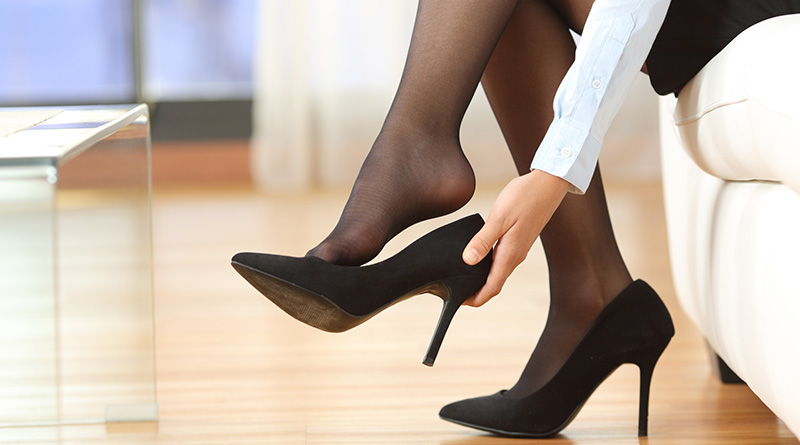Sexism in Politics – and beyond
In July of last year when Theresa May became only the second female Prime Minister in British history, much of the media coverage focussed on her gender and on her reported fetish for footwear. For the Sun, she was the shoe fanatic whose childhood dream was to be a politician. Goody Two Shoes said the Mirror, Theresa’s fancy footwork gets her the job, said the Daily Star.
Such attention was entirely predictable, of course. May, like any other female politician, is predominantly defined by her sexuality. In 2015, her appearance in Parliament on Budget day threatened to overshadow the Chancellor’s statement. In the Daily Mail, sketch writer Quentin Letts recorded that (note familiar use of first name) “Theresa sat in a suit so low-cut she could have been taken for Sam Fox”. An accompanying picture illustrated his point.
Then, in March this year the same newspaper published a front page photo colour photograph of The Prime Minister and Scottish leader, Nicola Sturgeon sitting beside each other. Never mind Brexit jeered the headline, who won Legs – it! This prompted former Labour Leader Ed Miliband to tweet that the “1950s called and asked for their headline back”.
I was reminded of all this when I read the news that Emily Owen, the Labour candidate for Aberconway in the forthcoming election, had been sexually harassed on social media. As reported by Mari Jones in this newspaper, Ms Owen has been subjected to comments about her “rack”, bra size and what sexual acts she would be prepared to perform in order to get votes. In a response posted on her Facebook page she wrote:
“If people have questions about my politics, discuss with me. If you don’t agree with my reply, challenge me……I’m sure Guto Bebb (the defending Tory MP) isn’t getting this kind of abuse simply because he’s not a young woman standing.”
And in that final point Owen is unfortunately correct: the effectiveness of women in political life is undermined by a general coverage which links their perceived characteristics to their gender. This just does not happen to men.
Let’s consider General Election 2015. As I’ve written elsewhere, the media attention received by Leanne Wood, Nicola Sturgeon and Natalie Bennett (leader of the Green party) indicates that we still have sections of a news culture fixated not on them as elected officials but as stereotypical representatives of their sex. Sturgeon in my view received the roughest treatment. On the BBC’s Newsnight of April 23 2015, her head was photo shopped onto the body of Kim Kardashian and The Scotweiler, as she was dubbed by the Sun, was routinely sexualised, patronised, demonised and even animalised.
And apart from informative portraits and interviews in The Guardian, there was little national focus on Leanne Wood. When she did hit the headlines in the first leader’s debate for challenging UKIP’s Nigel Farage’s “scaremongering” over immigrant’s use of the NHS, the Metro reported:
The votes are in and it’s clear which party member won ‘Biggest Heart Throb’ during the election 2015 debate.
Drum roll
Leanne Wood.
Yes, the Plaid Cymru leader had Twitter swooning when she took on Nigel Farage.
The key thing to consider amidst all this sexist coverage is that it was broadly all there was: analysis from Loughborough University found that women accounted for less than one in five of the individuals featured in election news coverage and that the second most prominent woman after Nicola Sturgeon was Samantha Cameron – so more attention paid to a leader’s wife than leading female politicians from all parties bar one. As researcher Emily Harmer so pertinently pointed out: the political institutions are dominated by men and so is the news coverage of those institutions. In GE 2015 just 15.2% of all politicians featured in the media coverage were women, 17.4% of articles were written by female journalists and a paltry 13.5% of experts consulted by the media were women.
In this sense, those that commented Emily Owen’s Facebook page or left disparaging comments below an article about her in the Mail Online are simply part of a wider political culture which has traditionally reduced women to their sexuality. We shouldn’t be surprised – such treatment is legitimised in politics at the highest level. The leader of the free world (for the moment, at least) is unashamedly and demonstrably sexist. Late in last year’s Presidential campaign when tape recordings emerged of Trump bragging that he could do anything to women without consent including grabbing them “by the pussy” his career did not end.
His career did not end.
Of course, what has happened to Emily Owen is not solely a political issue –online harassment of women is a global and cross cultural issue. Australian research published in 2016 reported that nearly half of all women surveyed reported experiencing abuse online and 76% of those were under 30. Forms of harassment included unwanted contact, sexual advances and threats of rape and death.
I’m not suggesting, and indeed I don’t know, that Ms Owen has experienced abuse of the vilest sort as highlighted in the above research. But we should not dismiss what’s happened to her as simple ‘banter’. Neither should we advise her to become battle hardened or get off line. The problem, I would argue, is that society has normalised such views to the extent that they are, to many people, acceptable and common place.
That said, as the many supporters of Ms Owen illustrate, challenges to the prevailing culture are also out there. The everyday sexism project founded by Laura Bates in 2012 to catalogue and share experiences of gender inequality is now established in 25 countries and 267,000 Twitter followers. .
Gender equality will benefit everybody, argues Bates , and sexism hurts us all. That’s right, surely?


